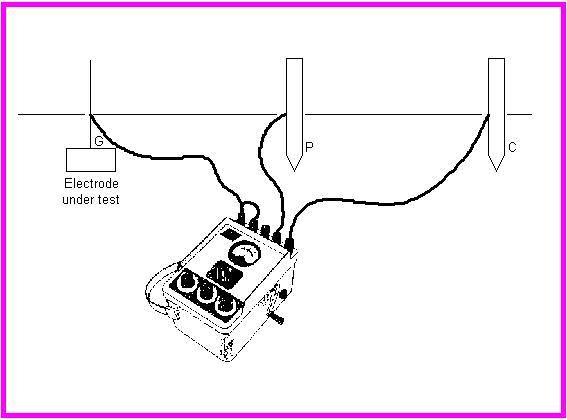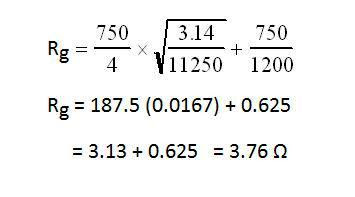In Article " How to Verify Ground Rod and Grid Installation ", I explained the following points:
- Practice#2: How to Verify Ground Grid Installation,
- Practice#3: How to Verify Ground Rod Installation.
Today, I will explain the following:
- Practice#4: How to Verify Connection / Interconnection Installation Ground Connection Requirements and
- Practice#5: How to Verify Fence Ground Installation.
You can review the following Articles For more information:
- Verifying Ground Rod Installation
- Verifying Ground Connection and Fence Ground Installation
- Identifying Correct Grounding Tools and Equipment
- Identifying Grounding Connectors and Bushings
- How to Calculate Ground Resistance
Practice#4: How To Verify Connection / Interconnection Installation Ground Connection Requirements
|
Use the following information
in this work aid and figures in the Information Section to help in identifying
connections to ground as follows:
1- Determine that buried connections are made by thermite welds, brazed or approved compression connectors and the grid interconnections are approved compression type or thermite welded.
2- Verify that no mechanical connections made are buried below grade.
3- Verify that grounding conductors from one equipment unit to another have not been looped.
4- Verify that all grounding conductors are as continuous as possible and that no unnecessary connections have been made.
5- Verify if ready disconnections for test purposes are provided in grounding connections to, generator neutrals, transformer neutrals, grounding electrodes such as groundwells or groups of ground rods, switchgear equipment ground buses, and switchgear neutral buses.
6- Verify that all grounding devices and conductors are installed so that they will be protected as much as possible against mechanical injury. In frequented areas, buried conductors, 120 mm2 (No. 4/0 AWG) or less, emerging from the ground should be protected by a non-metallic conduit for 6 to 12 inches (150 mm to 300 mm) above and below grade. Conductors should be ducted below concrete or where similarly inaccessible, preferably using non-metallic pipe. Metallic conduit and cable tray shall be grounded at each end . Make sure that these systems are electrically continuous.
7- Verify that the grounding bus forms a closed loop so that equipment ground and system neutrals tee-connected to it have 2 current paths.
8- Verify that where a site includes ground buses and ground grids in combination, and their ground resistance area overlaps, they must be interconnected by at least two conductors per bus or grid.
|
Exercise for Verifying
Connection / Interconnection Installation Ground Connection Requirements
Question#1: Buried connections are made by three
different means. What are they?
Answer: Thermite
welding, brazing, and compression.
Question#2: Mechanical connections are (choose
one) 1- permitted, 2- not
permitted to be buried below grade.
Answer: Mechanical connections are not permitted to be buried below grade.
Question#3: Looping of grounding conductors from
one equipment to another is (choose one) 1- permitted, 2- not permitted.
Answer:
Looping of grounding conductors from one equipment to another is not
permitted.
Question#4: All grounding conductors should be
as ………….. as possible and no
unnecessary connections should be made.
Answer: All grounding conductors should be as continuous as possible
and no unnecessary connections should be made.
Question#5: Ready disconnections for test
purposes should be provided in grounding connections to what?
Answer: to Rods, ground wells, generator and
transformer neutrals, switchgear equipment and switch gear neutral.
Question#6: All grounding devices and conductors
should be installed so that they will be protected as far as possible against
………………. In frequented areas, buried conductors, sized ………………… or less,
emerging from the ground should be protected by a non-metallic conduit for ….. To …….. inches above and below grade.
Answer: All grounding devices and conductors
should be installed so that they will be protected as far as possible against
mechanical damage. In frequented areas, buried conductors, sized 4/0
AWG (120 mm2) or less, emerging from the ground should be protected by
a non-metallic conduit for 6 to 12 inches above and below grade.
Question#7: The grounding bus forms a closed
loop so that equipment ground and system neutrals tee-connected to it have
how many current paths?
Answer: 2 Paths
Question#8: Overlapping ground buses and ground
grid areas should have a minimum how many conductors per bus or grid
interconnect?
Answer: 2 Conductors
|
Practice#5: How to Verify Fence
Ground Installation
|
Use the following information
in this work aid to help in identifying fence grounds as follows:
1- Verify that the following
fences are grounded:
2- Determine whether the fence
has been built to an SSD/1 type. If so, no grounding is
required.
3- Verify that ground wells are
located as shown on the drawing used for inspection and are connected to the
grounding conductor.
4- Verify that the grounding
conductor has a minimum of two connections to the ground grid.
5- Verify that the peripheral
grounding conductor of the substation is
approximately 3ft (1 m) outside and parallel to the fence.
6- Verify that the fence is
bonded to the peripheral grounding conductor at intervals of 50 feet (15 m)
with a minimum size of 70 mm2 (2/0 AWG)
7- Verify that metal posts are
used for the substation fence.
8- Verify that corner and gate
posts are bonded to the parallel conductor and gates are bonded to gate posts
with flexible connectors.
|
Exercise for Verifying Fence Ground Installation
Question#1: Determine if the following fences are to be
grounded:
Answer:
Question#2: A fence has been built SSD/1 type. What type of grounding is
required?
Answer: none.
Question#3: Ground wells are usually located where?
Answer: diagonally.
Question#4: How many connections should the grounding
conductor located outside the fence area have to the ground grid?
Answer: 2 connections.
Question#5: How far should the peripheral grounding
conductor be located from a substation fence?
Answer: 2 to 3 feet.
Question#6: A substation rated above 13.8 kV has a
fence bonded to the peripheral grounding conductor at intervals of …………….. With
a minimum size of ………… conductors.
Answer: A substation rated above 13.8
kV has a fence bonded to the peripheral grounding conductor at intervals of 50
FEET with a minimum size of _2/0 conductors.
Question#7: What type of posts are used for a
substation fence?
Answer: metal Post.
Question#8: To what are the corner and gate posts
grounded to? How are gates bonded?
Answer: Corner and gate posts must be
connected to the grounding conductor. Gates must be bonded to gate posts with
Parallel conductor and flexible connectors.
|























